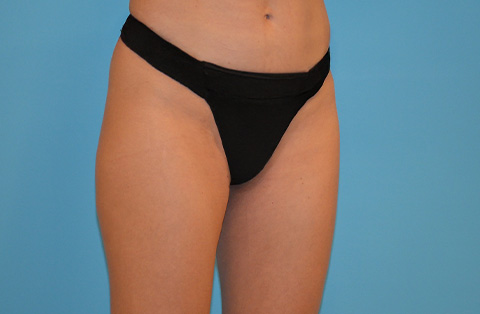Are you frustrated with sagging skin on your inner thighs?
A vertical thigh lift can transform your legs, giving you a firmer, more youthful appearance. This comprehensive guide will cover everything you need to know about the vertical thigh lift procedure, recovery process, and what to expect before and after surgery.
We'll also delve into the costs involved, helping you make an informed decision about this life-changing procedure. Explore how a vertical thigh lift can enhance your body contours and boost your confidence.
What is a Vertical Thigh Lift?
A vertical thigh lift is a surgical procedure designed to remove excess skin and fat from the inner thighs. This procedure involves making a vertical incision along the inner thigh, extending from the groin to the knee.
It is particularly effective for individuals with significant sagging due to massive weight loss or aging. The goal is to tighten and smooth the skin, resulting in firmer, more contoured thighs.
This plastic surgery not only enhances the appearance of the legs but also improves comfort and confidence in clothing. It is ideal for those seeking a more proportional and toned lower body.
Related Content:
Who is an Ideal Candidate for Vertical Thigh Lift?
If you're struggling with loose, sagging skin on your inner thighs that exercise and diet can't fix, a vertical thighplasty might be the solution for you. This procedure can significantly improve the contour and firmness of your thighs, enhancing both appearance and confidence. Wondering if you're a good fit for this surgery? Here are the characteristics of an ideal candidate:
Individuals with significant sagging skin on the inner thighs.
Massive weight loss patients.
People in good overall health.
Non-smokers or those willing to quit before surgery.
Individuals with a stable weight.
Those with realistic expectations about the outcomes.
People committed to maintaining a healthy lifestyle post-surgery.
What is the Difference Between Medial and Vertical Thigh Lift?
The main difference between a medial and a vertical thigh lift lies in the incision placement and the areas they target.
A medial thigh lift focuses on the upper inner thigh, with an incision made in the groin area. It primarily addresses sagging skin in the upper thigh region.
In contrast, a vertical thighplasty involves a longer incision that runs vertically along the inner thigh from the groin to the knee. This procedure is ideal for individuals with extensive sagging skin along the entire inner thigh.
Both procedures aim to tighten and contour the thighs but cater to different extents of sagging.
Preparing to Surgery and Schedule Your Consultation
Preparing for a the surgery involves several important steps to ensure the best outcomes. From understanding the procedure to planning your recovery, thorough preparation is key. Scheduling a consultation with a qualified surgeon is the first step toward achieving your desired results. During this consultation, you can address any concerns and get detailed information about the surgery.
Questions to Ask Your Surgeon
What experience do you have with vertical thighplasty surgeries?
Am I a good candidate for this procedure?
What are the potential risks and complications?
What will the recovery process be like?
How long will the results last?
What type of anesthesia will be used?
Can I see before and after photos of previous patients?
What should I do to prepare for the surgery?
What is the total cost, including any potential additional fees?
How can I ensure the best results post-surgery?
How is Vertical Thigh Lift Surgery Performed?
Vertical thighplasty surgery involves several key steps to ensure effective contouring and tightening of the inner thighs. Here's a step-by-step breakdown of the procedure:
Anesthesia The surgery begins with administering anesthesia. General anesthesia is commonly used to ensure patient comfort throughout the procedure.
Incision The plastic surgeon makes a vertical incision along the inner thigh. The incision typically extends from the groin to the knee, allowing for maximum removal of excess skin and fat.
Liposuction (if needed) If there is excess fat that needs to be removed, the surgeon may perform liposuction. This step helps in contouring the thighs for a smoother appearance.
Skin and Tissue Removal The surgeon removes excess skin and underlying tissue. This step is crucial for tightening the thigh area and achieving the desired contour.
Reshaping and Tightening The remaining skin is reshaped and pulled tight to create a firmer, more youthful appearance. The surgeon ensures that the new contours are smooth and natural-looking.
Closing the Incision The surgeon carefully closes the incision with sutures. In some cases, temporary drains may be placed to prevent fluid accumulation.
Bandaging and Compression Garments The treated area is bandaged, and a compression garment is applied. This helps reduce swelling and supports the new thigh contours during the initial healing phase.
Recovery Monitoring The patient is monitored as they wake up from anesthesia. Post-operative instructions are provided to ensure a smooth recovery process.
Vertical Thigh Lift Recovery Process
The recovery time and process after a the surgery involves several stages. Understanding the timeline helps you prepare for a smooth and effective recovery. Here's what to expect:
First Week
Day 1-2: Rest and limit movement. You may experience swelling, bruising, and discomfort. Pain medication and antibiotics are prescribed.
Day 3-7: Gradually increase light activities. Continue wearing compression garments to minimize swelling and support healing.
Weeks 2-3
Week 2: Return to non-strenuous activities. Swelling and bruising should start to subside. Continue following post-operative care instructions, including incision care.
Week 3: Begin gentle walking to improve circulation, but avoid strenuous activities or heavy lifting.
Weeks 4-6
Week 4: Most patients can return to work, especially if it involves light duties. Continue wearing compression garments as directed by your surgeon.
Week 6: Resume more regular activities. Swelling should significantly decrease. You can start gentle exercise, avoiding any activities that strain the thighs.
Months 2-3
Month 2: Continue monitoring healing progress with your surgeon. Most swelling should be gone, and you’ll start to see the final results.
Month 3: Resume all normal activities, including more vigorous exercise. Scars will continue to fade over time.
Long-term Care
Follow a healthy lifestyle to maintain results. Keep the skin moisturized and protected from the sun to aid in scar healing.
Attend all follow-up appointments to ensure proper healing and address any concerns.
Proper adherence to your surgeon's instructions during the recovery process ensures optimal results and a smoother recovery experience.
Vertical Thigh Lift Before & After : Transformative Results

Before and after photos of vertical thigh lift surgeries showcase the transformative effects of the procedure. These cases typically reveal significant improvement in thigh contour, with smoother, tighter skin and a more toned appearance.
How Much does a Vertical Thigh Lift Cost?
The cost of a vertical thighplasty varies based on location, surgeon experience, and facility fees. In the United States and Western Europe, the procedure typically ranges from $7,000 to $13,000. This includes surgeon fees, anesthesia, and post-operative care.
In Turkey, the cost is significantly lower, usually ranging from $3,000 to $5,000. The lower cost in Turkey is due to lower living expenses and operating costs, making it an attractive option for medical tourists seeking quality care at more affordable prices. Despite the cost difference, it's essential to choose a qualified, experienced surgeon to ensure the best results.
Potential Risks and Complications
While the procedure can yield impressive results, it’s important to be aware of the potential risks and complications involved. Understanding these risks helps you make an informed decision and prepare for the surgery. Here are some of the potential risks and complications:
Infection
Bleeding or hematoma
Poor wound healing
Scarring
Asymmetry or uneven contours
Blood clots
Nerve damage or changes in skin sensation
Adverse reactions to anesthesia
Fluid accumulation (seroma)
Prolonged swelling or bruising






